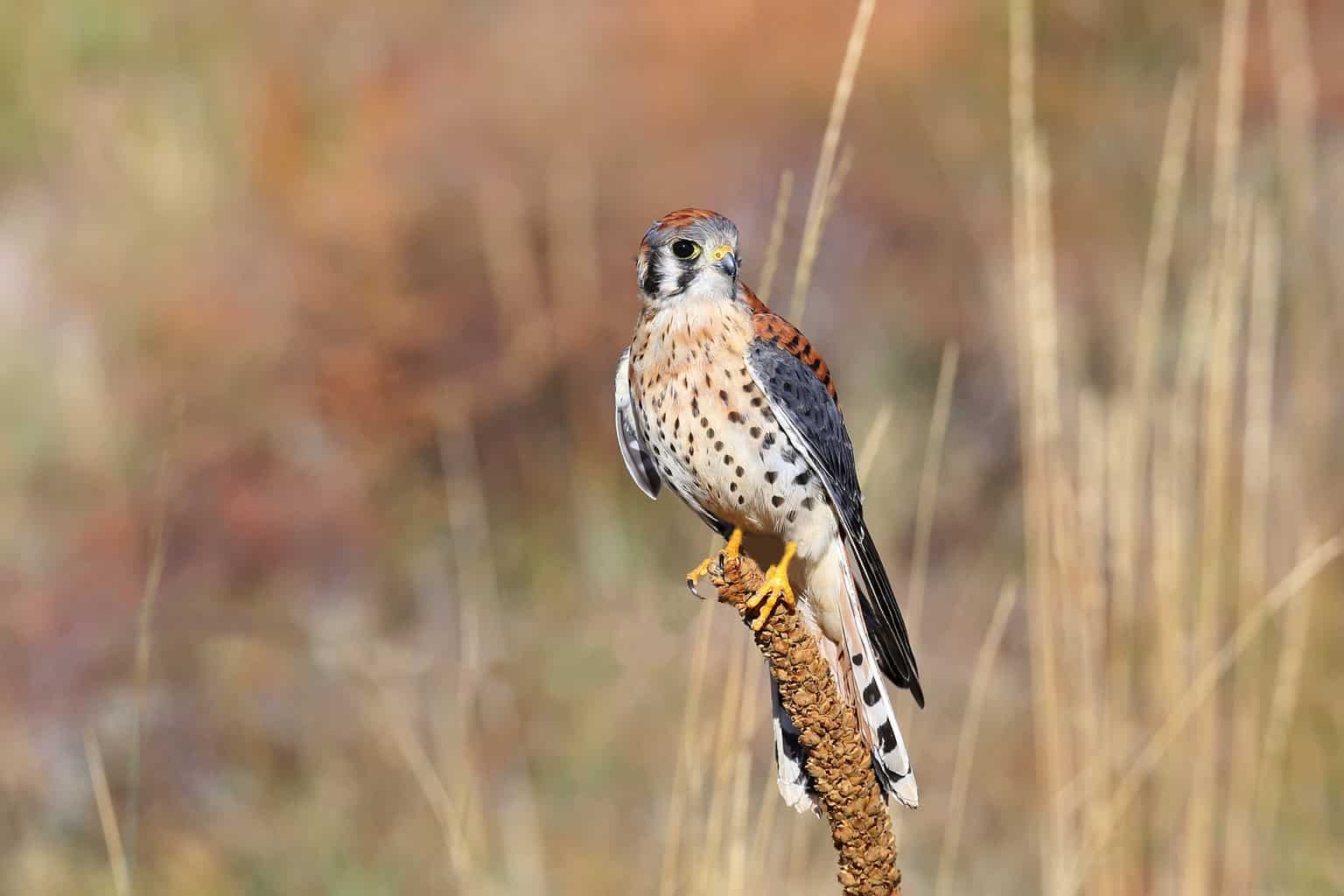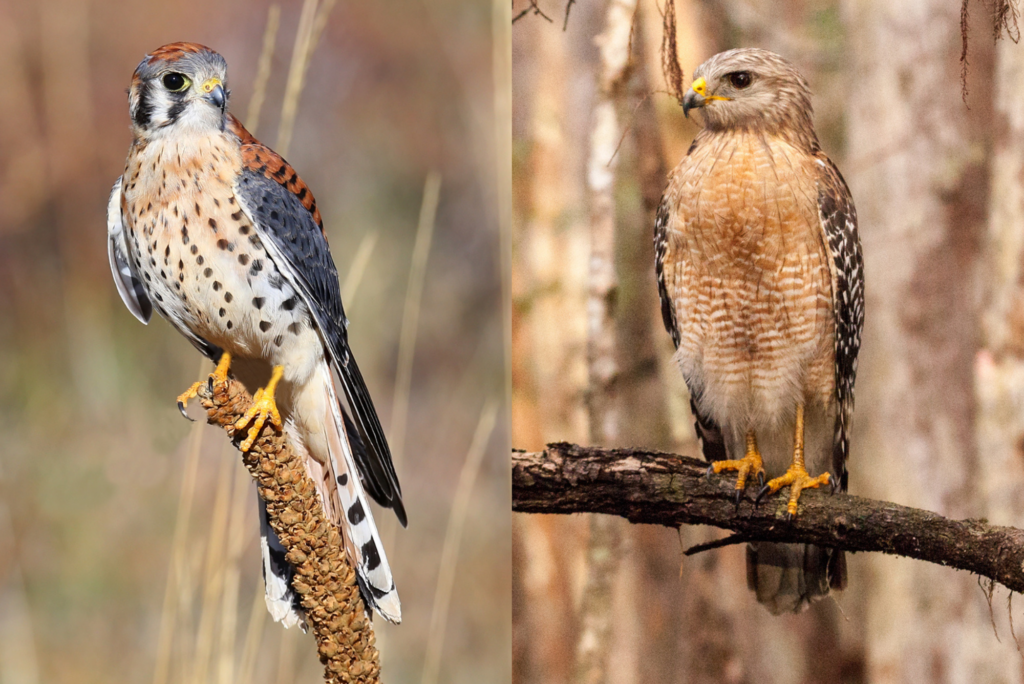The American kestrel, Falco sparverius, is a fascinating bird. It has also been mistaken for a sparrow hawk, a grasshopper hawk, and a killy hawk.
DNA evidence placing this bird more accurately within the Falco genus means that the name kestrel may change in the future as scientists find out more about the evolutionary history of these birds.
Is a Kestrel a hawk?
Though it is also known by many as the sparrow hawk, it is not a hawk but rather a falcon – the smallest and most common falcon in North America.
The common name of sparrow hawk arose from a mistaken belief that this bird was related to the Eurasian sparrowhawk – of the Accipiter genus.

The bird was officially renamed “American kestrel” in the sixth edition of the AOU Checklist of North American Birds.
What is the difference between a kestrel and a falcon?
The kestrel is more closely related to the larger American falcons like the aplomado, peregrine, and prairie falcons than to true kestrels. So, though the name has stuck (at least for now), kestrels are actually falcons.
Of course, plenty of other birds within the Falco genus also exist. So while all American kestrels are falcons, not all falcons are American kestrels.
How to Recognize an American Kestrel
It is also essential to understand that there is not one American kestrel but seventeen different subspecies of this type of bird found throughout the Americas. Though these subspecies have much in common, there are differences based on plumage, size, and the vocalizations each makes.
However, there are some general things to look for when trying to identify an American kestrel:
Size
The kestrel is the smallest falcon in North America, varying in size (depending on the specific subspecies) from around the weight of a blue jay to the weight of a mourning dove.
The females are moderately larger than the males, showing sexual dimorphism in both size and plumage. Though the size difference between the males and females is less pronounced than in larger falcons, females tend to be around 10-15% larger.
The birds range between 22 and 31 centimeters in length, with a wingspan of between 51 and 61 centimeters.
American kestrels are leaner and less muscular than larger falcons. Their flight muscles take up only 12% of their body weight, compared with roughly 20% for larger falcons like the peregrine.
Their wings are long and quite narrow, tapering to a point. This, along with their relatively light weight, allows them to spend a long time on the wing, chasing and hunting their prey. Though small, they are strong – able to take birds even as large as they are – or even occasionally larger.
Appearance

Males have blue-gray wings with black spots, white on the underside with black barring. They have rufous backs with barring on the lower half, white flanks and belly with black spotting, and rufous tails with a black subterminal band.
The females have rufous backs and wings with dark brown barring, and are creamy to buff-colored underneath with heavy brown streaking. Their tails differ from the males and are rufous with many black bars.
Both males and females have white heads with a bluish-gray top and two narrow vertical facial markings on each side of the head. Two black spots, believed to function like false eyes, are found on each side of the white or orangish nape.
Vocalization
American kestrels can also be identified by their vocalizations. There are three key noises – the ‘klee’ or ‘killy’ call gives this bird one of its common names. This noise is made repeatedly when the kestrel is upset or excited.
Where American Kestrels are Found
American kestrels are found in many habitats, including grasslands, meadows, deserts, and urban and suburban areas. They need open spaces for hunting, perches, and cavities for nesting but can cope with very diverse conditions, from Northern Canada and Alaska all the way south to Tierra del Fuego.
Birds breeding south of about 35° north latitude typically remain year-round residents. While further north, American kestrels will be present in summer and migrate south in winter.
How American Kestrels Differ from Hawks
Hawks are birds of prey of the family Accipitridae. Within this family is Accipitrinae, which includes goshawks, true sparrowhawks, sharp-shinned hawks, etc.
In America, members of the Buteo group are also called hawks, though these are referred to as buzzards in other parts of the world.
This bird family includes kites, harriers, eagles, hawks, and buzzards, though they are not typically referred to as hawks.
A lot of confusion arises, however, because many other birds are also referred to as hawks, even when they are no relation to the true hawks of the Accipitridae family.
Hawks are not one single species, and there is a lot of variety among the members of the Accipitridae and Buteo groups.
There are many differences between kestrels and the various hawks that you might see in North America.
The smallest Accipiter hawks are the sharp-shinned hawks. Males are typically 23-30 centimeters long, with a wingspan of 42-58 centimeters. But their coloration, etc., means they are not usually confused with American kestrels.
One interesting thing to note is that American kestrels will sometimes use the abandoned nests of other birds, such as red-tailed hawks.
How American Kestrels Differ from Other Falcons
The American kestrel is believed to be the most abundant falcon in North America, so you are more likely to see one of these than any of the other falcons present in the region. However, sadly, the species is experiencing severe declines in some areas.
One other small species of falcon that might be confused with the American kestrel is Falco columbarius, colloquially once known as a pigeon hawk but now commonly referred to as a merlin. Merlins typically have wingspans of 50-73 centimeters, and females are slightly larger than males. In recent decades the number of these birds in North America has been increasing.
The merlin might be part of ancient non-monophyletic radiation of Falcos from Europe to North America, alongside the ancestors of forms such as the American kestrel. Today, there are three types in the American group – taiga or tundra merlin, prairie merlin, and black merlin, or coastal forest merlin.
The merlin is more robust and heavily built than the American kestrel and other small falcons. The male is blue-gray on its back, ranging from almost black to silvery depending on the subspecies. The undersides of the males are buff to orange and heavily streaked with black to reddish brown. Females and juveniles are brownish-gray to dark brown on their backs and whitish-buff spotted with brown below.
Light American males may resemble the American kestrel, but merlin males have a gray back and tail rather than the reddish-brown of the kestrels.
The American kestrel is the only New World species termed “kestrel.” However, as mentioned above, it is now not believed to be closely related to other kestrels, such as the Eurasian kestrel (common kestrel), which are found within a different clade of the Falco genus.
The aplomado falcon, peregrine falcon, and prairie falcon, though believed to be more closely related to the American kestrel, do not closely resemble it and are all larger.

